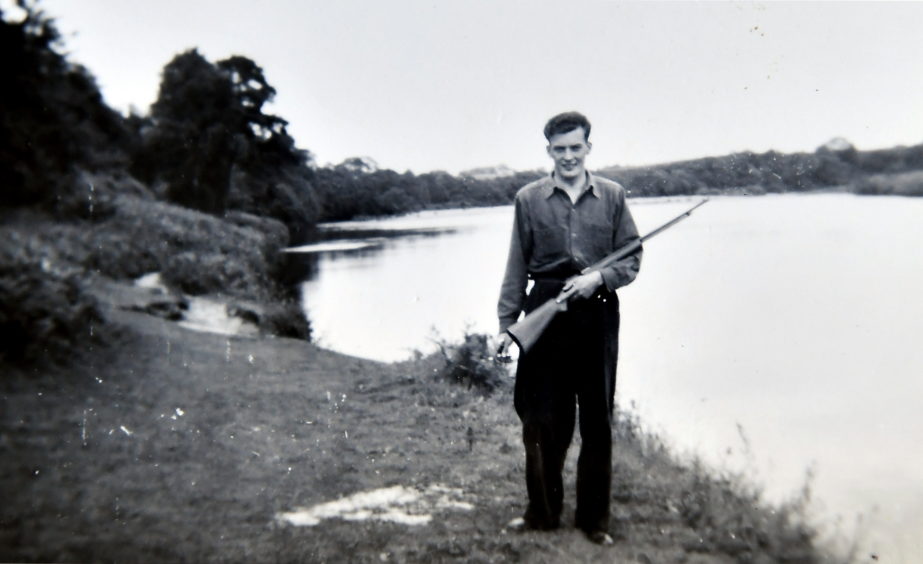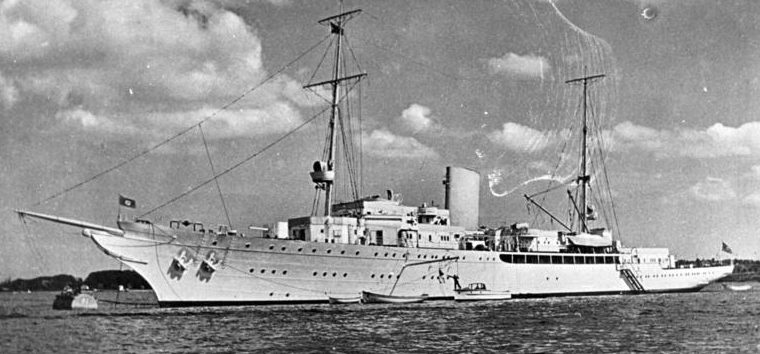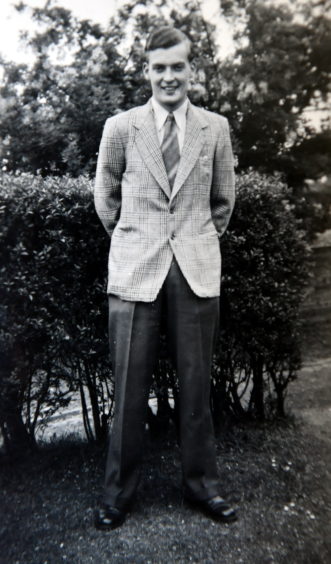An Aberdeen man has told how he kept a piece of Adolf Hitler’s luxury war yacht in his sock drawer after it crashed in Fife 75 years ago.
The Aviso Grille was one of the biggest yachts in the world and regular visitors included members of the Third Reich hierarchy, such as Goering, Hess, Goebbels and Himmler.
White Swan of the Baltic
The boat, which was nicknamed White Swan of the Baltic, was intended to convey Hitler in triumph to London where he would take over Windsor Castle as his home after the planned Nazi conquest of Britain as part of Operation Sea Lion.
During the war, the Grille was put into combat before she was reduced to a headquarters ship for the commander of naval forces in occupied Norway.
The flag was flying at half-mast when the yacht was captured just days after Hitler’s death.
Angus naval officer George Murrie Strachan from Kingoldrum was present when the British Navy took it as a prize of war after the liberation of Norway.
The yacht was then taken to Scotland by the German crew, under a Royal Navy escort, with only one working boiler after the rest and some of the engines had been sabotaged.
The Royal Navy’s Chief Engineering Officer Jim MacPhee said that they had so much engine trouble on the journey that if Hitler had been in charge he would have shot somebody.
Shorn of all but one small Swastika, though still bearing her original name in large Gothic letters, the yacht bizarrely ended up being docked in Fife in May 1945.
Short piece of wood
Aberdeen man Cyril (Mac) Caseby, 89, started work at Rosyth Naval Dockyard from the age of 14.
He looked on as the boat arrived from Trondheim and its projecting bow was damaged while it was being berthed.
Mr Caseby picked up a short piece of wood which broke off the yacht and took it home.
He said: “The Royal Navy discovered Hitler’s yacht in a Norwegian fjord and brought it back to Rosyth soon after the war ended.
“I saw it come in and while it was being berthed the front scraped against the concrete and a small bit broke off and I took it.
“I was curious as it looked like no other ship in the dockyard and I had no idea about it or its past.
“It was only when I had got hold of the piece of wood that was scraped off that someone told me that it was Hitler’s yacht that had been brought into service in the German Navy in Norway.
“The wood was only a short piece of grey painted wood about eight inches long and it spent its life in my sock drawer until my mother disposed of it in 1958.
“I was getting married and there was a delay in the entry date to the flat in Aberdeen we were to move in to.
“This meant that I was to bring back my new bride to our home for a few weeks.
“Being my mother, she was looking in my sock drawer beforehand to see if there were any dirty socks there or any with holes in them.
“When finding the bit of wood at the back, she must have wondered what it was doing there and disposed of it.
“It ended up being put on the fire.”
Walking in the footsteps of Hitler
Mr Caseby told how he got on board the ship and walked in the footsteps of Hitler.
He said: “I was determined to get on board to have a good look and waited until there was no activity on it.
“I could only walk around the deck and look in the windows because everything was locked up.
“It did not look very luxurious but much would have been stripped out by then.
“The yacht looked in reasonably seaworthy condition and was painted in the usual naval colours.
“How did I feel at the time?
“A bit nervous as I had no right to be on board but conscious of the fact that I had been walking exactly in the same place as Hitler which brought about a feeling of discomfort.”
In Rosyth, naval personnel stripped the ship of anything valuable including a diary for the year 1944 that came from the Grille, with a foreword by Adolf Hitler.
Strict security
The last entry in the ship’s log read: ‘May 2-4: Flag at half-mast in memory of the hero’s death of our Fuhrer’.
Mr Caseby said: “As far as I remember security was very strict.
“When leaving everybody had to walk between a row of security people stretched across the exit and when you got a tap on your shoulder you had to go into a nearby building to be frisked.
“The penalty for theft was severe.
“How did I get the piece of the yacht out?
“I just carried it openly in my hand and was never asked.
“If I had been I would have said it was only a piece of firewood because that is what it looked like.
“There was a story that I do not know if it was true or not although many said it was true.
“Every night a labourer came to the exit hurling his barrow with only his flask and piece box in it, sometimes covered with his duffle coat.
“This was properly checked each time before he went on his way.
“Later it was discovered that he was stealing wheelbarrows.”
Coal dock at Hartlepool
Too big to stay in a busy port, the Grille was then towed to the coal dock at Hartlepool where it stayed until 1948 with a view to being sold.
George Arida, a Lebanese textile manufacturer, bought the yacht for a reported price of £357,000.
Mr Arida was secretly representing King Farouk of Egypt, who did not want to be publicly associated with the purchase of Hitler’s yacht.
In Beirut, anti-Farouk terrorists attached two mines to her hull, causing only minor damage, but he lost interest in his purchase, leaving Mr Arida stuck with both the ship and the bill.
Grille was steamed to New York, where Mr Arida hoped to find someone interested in converting her into a luxury cruise ship or floating casino.
He was unable to secure a buyer, and Grille was instead moored in New York and left idle for the next two years.
While there, the ship briefly again became a tourist attraction.
Hitler’s throne
But the US government stepped in and said it was time to destroy the yacht to prevent it becoming a Nazi relic.
In April 1951, it was sold for scrap for £35,000 and the vessel was towed to a yard on the Delaware river to be broken up.
Before the scrapping began, souvenir hunters removed artefacts from the vessel at the now defunct Doan Salvage Company on the outskirts of New Jersey.
The yacht’s toilet was one of many relics which became scattered throughout New Jersey, before it was purchased by British military memorabilia collector, Bruce Crompton.
Life and times of Hitler’s war yacht
The Grille was built at the Lurssen yard in Bremen in 1935 by the German company of Blohm & Voss for about $4 million,
The grille was the biggest yacht in the world at the time, and it was too big to get into most harbours.
In 1937, the boat left on its first voyage to England, carrying the German delegation for the coronation of King George VI.
After the start of World War Two, Grille was used as a mine-layer and as a patrol vessel in the Baltic Sea, tasked with searching for enemy merchant vessels.
She collided with a German transport ship in January 1940 and after repairs, resumed mine-laying duties in the North Sea, thereafter being used as a gunnery training ship.
She was briefly assigned to the mine-laying unit tasked with supporting Operation Sea Lion in September before the planned invasion of Britain was cancelled, and she was reassigned to the Baltic during Operation Barbarossa, the German invasion of the Soviet Union in June 1941.
Gunnery training duties followed from August 1941 until March 1942, when she was reduced to a headquarters ship for the commander of naval forces based in occupied Norway.















